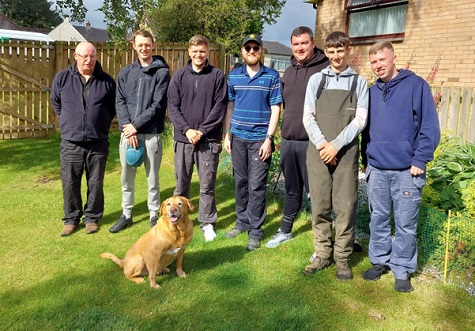As a former greenkeeper myself, I know only too well the up and downs, the life changing experiences and the challenges you face while working as a practicing greenkeeper.
A recent conversation with Bruce Cruickshank, a well-respected golf course manager who has spent most of his working career caring for several golf courses, allowed me to hear of his experiences of taking on a new challenge at Hamilton Golf Club.

Aerial photo of Hamilton GC
Where did you work prior to taking the Hamilton job?
I started my career at Falkirk Carmuirs, Stirlingshire as an apprentice earning £40 per week. I then progressed to Hartsbourne Golf and Country Club, Hertfordshire to finish my apprenticeship, where I spent time learning the basics of greenkeeping and working towards a more senior post.
I subsequently moved to Saunton Golf in Devon as first assistant. After a couple of years I then got my first head greenkeeper position at Crail Golfing Society in Fife.
After a challenging five years, I moved to The Nevill in Royal Tunbridge Wells as course manager. This soon led to a further opportunity when I was headhunted to take on the role of course manager at The Roxburghe in the Borders where I was responsible for the grow-in. I was also responsible for preparing the course for a series of televised events, including five European tours.
After 14 years at the Roxburghe, I felt a new challenge was needed and moved to Hamilton where I took on a long list of jobs to bring the golf course back into a playable condition.

Bruce Cruickshank
What type of course is Hamilton and what issues have you faced?
A feature of the original layout of the course is the number of bunkers that were clay lined. We have started a bunker programme to reposition, reshape and install drainage, with the greenside being lined with capillary concrete. The fairway bunkers will be completed over the next two winters.
The championship standard course is a mature parkland design, framed by over twenty species of trees, and measures over 6,600 yards from the back tees. The condition of the course was not great when I joined. The greens were soft and the irrigation system was a 1970s Cameron where the glued joints were leaking to the extent we did not know what was a drainage or irrigation issue. The machinery was rented and 8 - 10 years old, which mean it was constantly breaking down.
All the greens are soil push-up and, with the course lying on a very heavy boulder clay, up to 30 metres deep in places. They would often become waterlogged after heavy spells of rain and, therefore, unplayable.
One of my first tasks was to take soil samples to see exactly what each green was sat on. Once we knew what we were dealing with, we set to work on improving the greens and work began in earnest after a new irrigation system was installed. All the greens had new drains installed and we attacked the organic matter using the GKD sand filler and improved the secondary drainage with the Imants SandCat.
The results were dramatic. We have gone from greens that you could hardly walk on to ones that are very firm.
As for staff, I have seven people including assistant course manager, Brian Scott, senior greenkeeper Martin Scott, Ggreenkeepers Iain Douglas and Conner Falconer, and apprentices James Brown, Aidan Dunne and James Mcfarlane. All of the staff have worked with me from apprenticeship level.

Evening sunshine at Hamilton GC
What is your typical work regime?
We usually arrive at 5.30 for a 5.45 start. The greens are cut daily at 4mm and rolled three times per week. Fairways are cut three times and tees and aprons twice. Bunkers are raked three times and the holes moved three times. Semi rough is ongoing all week. Wednesday afternoons are kept for maintenance checks. Thatchaways from Greentek are used twice monthly to aid control of organic matter.
Cutting heights on the greens are 3.5-4mm in the summer and between 6-7mm in the winter, cutting twice a day using Jacobsen G-Plex triple mowers.
I like to topdress the greens heavily in the autumn and spring and allow the grass to grow through then lightly in the summer just to improve the surface. I aim to get around 120 tonnes of material onto the greens each year.
Aeration is carried out once a month to greens, tees and fairways. We have a Wiedenmann Terra Spike GXi solid tine aerator that is in constant use throughout the autumn and winter. We use ¾" Hamilton VertiDrain solid tines on the fairways and ½" tines on greens and tees. We've also got a Toro ProCore which is used on the greens and tees. We also sarrel roll the greens on a regular basis.
Tees and surrounds are cut at 9mm all year round. Fairways at 12mm and the rough is maintained at 50mm. Our fertiliser programmes consist of a combination of granular and liquid formulations at the start of the growing season.

Hamilton greenkeeping staff
What machinery have you introduced at the club since you started?
We had quotes in from Ransome Jacobsen, John Deere and Toro. After deliberation and discussion with the various parties, we felt that the best quote, backup and value for money was Ransome Jacobsen - who through Fairways GM, the club has had a relationship with for 12 years with no issues.
A new Toro irrigation system, updating the old Cameron system was installed in 2017 and has helped us produce better playing surfaces.
I also introduced a full PrimoMaxx programme to our greens, tees and bunker surrounds. This has helped reduce cutting time spent on bunker faces which, in the past, had to be cut on a weekly basis. Now, they are only cut once a month which saves time and labour and frees up the staff for other tasks.
What’s next for you?
Now after 13 years working at Hamilton I have finally decided to move on and have a complete career change. I have offered my services to teach and encourage the next generation of greenkeepers to come into our industry.
I have recently taken up a post at East Durham College enabling me to become a lecturer and trainer in horticulture and greenkeeping.
Our industry is going through a lot of turmoil in attracting and retaining greenkeepers. Pay and often working conditions are poor compared to other industry sectors. It seems youngsters today do not want to work unsociable hours and expect better prospects and pay.
You can earn more money driving a white van or working at McDonalds! However, we need to change the mindset of these youngsters and show them the real benefits of working in this unique industry. My own working career clearly shows the opportunities that can be had if you dedicate yourself and are willing to move around.
However, having said all that, I do really think it is about time golf clubs and industry governing bodies work together to ensure their most valued staff, the greenkeeping team, get the recognition, pay and conditions they deserve for maintaining these very diverse and unique golf courses up and down the country.